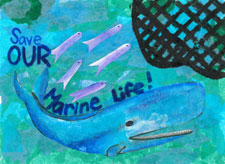May 21, 2015 — Four college buddies on an angling trip in the Long Island Sound this week came home with one heck of a fishing story — and the video to back it up.
Schofield Campbell, Charlie DeNatale, Ryan Bard and Brendan Miner were fishing off the coast of Fairfield, Connecticut, when they say they spotted a group of light gray forms underwater.
Those forms turned out to be whales, and they seemed to be following the boat. Video shows the marine mammals approach the boat and swim alongside it, breaching several times before disappearing back into the sea.

